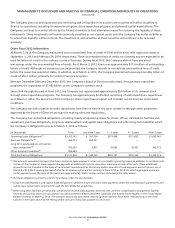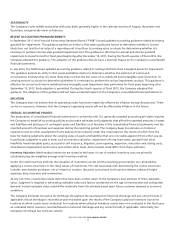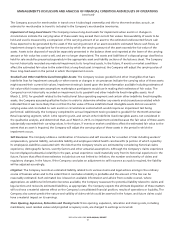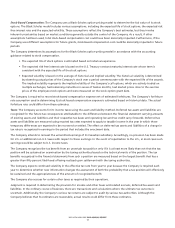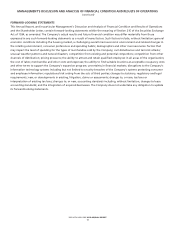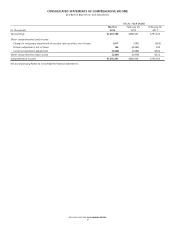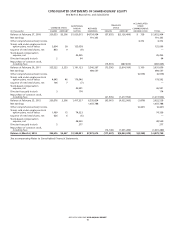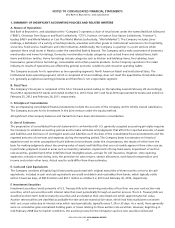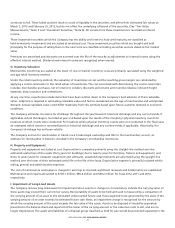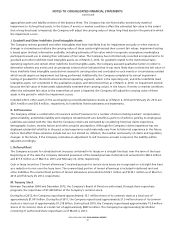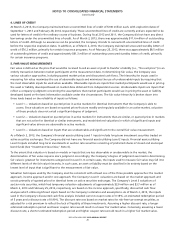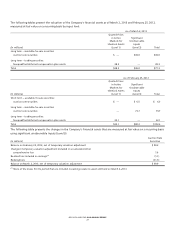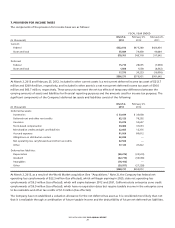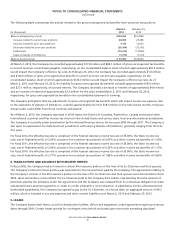Bed, Bath and Beyond 2012 Annual Report Download - page 22
Download and view the complete annual report
Please find page 22 of the 2012 Bed, Bath and Beyond annual report below. You can navigate through the pages in the report by either clicking on the pages listed below, or by using the keyword search tool below to find specific information within the annual report.1. SUMMARY OF SIGNIFICANT ACCOUNTING POLICIES AND RELATED MATTERS
A. Nature of Operations
Bed Bath & Beyond Inc. and subsidiaries (the ‘‘Company’’) operates a chain of retail stores under the names Bed Bath & Beyond
(‘‘BBB’’), Christmas Tree Shops or andThat! (collectively, ‘‘CTS’’), Harmon or Harmon Face Values (collectively, ‘‘Harmon’’),
buybuy BABY and World Market or Cost Plus World Market (collectively, ‘‘World Market’’). The Company includes Linen
Holdings, a distributor of a variety of textile products, amenities and other goods to institutional customers in the hospitality,
cruise line, food service, healthcare and other industries. Additionally, the Company is a partner in a joint venture which
operates three retail stores in Mexico under the name Bed Bath & Beyond. The Company sells a wide assortment of domestics
merchandise and home furnishings. Domestics merchandise includes categories such as bed linens and related items, bath
items and kitchen textiles. Home furnishings include categories such as kitchen and tabletop items, fine tabletop, basic
housewares, general home furnishings, consumables and certain juvenile products. As the Company operates in the retail
industry, its results of operations are affected by general economic conditions and consumer spending habits.
The Company accounts for its operations as two operating segments: North American Retail and Institutional Sales. The
Institutional Sales operating segment, which is comprised of Linen Holdings, does not meet the quantitative thresholds under
U.S. generally accepted accounting principles and therefore is not a reportable segment.
B. Fiscal Year
The Company’s fiscal year is comprised of the 52 or 53 week period ending on the Saturday nearest February 28. Accordingly,
fiscal 2012 represented 53 weeks and ended on March 2, 2013; fiscal 2011 and fiscal 2010 represented 52 weeks and ended on
February 25, 2012 and February 26, 2011, respectively.
C. Principles of Consolidation
The accompanying consolidated financial statements include the accounts of the Company and its wholly owned subsidiaries.
The Company accounts for its investment in the joint venture under the equity method.
All significant intercompany balances and transactions have been eliminated in consolidation.
D. Use of Estimates
The preparation of consolidated financial statements in conformity with U.S. generally accepted accounting principles requires
the Company to establish accounting policies and to make estimates and judgments that affect the reported amounts of assets
and liabilities and disclosure of contingent assets and liabilities as of the date of the consolidated financial statements and the
reported amounts of revenues and expenses during the reporting period. The Company bases its estimates on historical
experience and on other assumptions that it believes to be relevant under the circumstances, the results of which form the
basis for making judgments about the carrying value of assets and liabilities that are not readily apparent from other sources.
In particular, judgment is used in areas such as inventory valuation, impairment of long-lived assets, impairment of auction
rate securities, goodwill and other indefinite lived intangible assets, accruals for self insurance, litigation, store opening,
expansion, relocation and closing costs, the provision for sales returns, vendor allowances, stock-based compensation and
income and certain other taxes. Actual results could differ from these estimates.
E. Cash and Cash Equivalents
The Company considers all highly liquid instruments purchased with original maturities of three months or less to be cash
equivalents. Included in cash and cash equivalents are credit and debit card receivables from banks, which typically settle
within 5 business days, of $87.8 million and $67.1 million as of March 2, 2013 and February 25, 2012, respectively.
F. Investment Securities
Investment securities consist primarily of U.S. Treasury Bills with remaining maturities of less than one year and auction rate
securities, which are securities with interest rates that reset periodically through an auction process. The U.S. Treasury Bills are
classified as short term held-to-maturity securities and are stated at their amortized cost which approximates fair value.
Auction rate securities are classified as available-for-sale and are stated at fair value, which had historically been consistent
with cost or par value due to interest rates which reset periodically, typically every 7, 28 or 35 days. As a result, there generally
were no cumulative gross unrealized holding gains or losses relating to these auction rate securities. However, beginning in
mid-February 2008 due to market conditions, the auction process for the Company’s auction rate securities failed and
NOTES TO CONSOLIDATED FINANCIAL STATEMENTS
Bed Bath & Beyond Inc. and Subsidiaries
BED BATH & BEYOND 2012 ANNUAL REPORT
20


